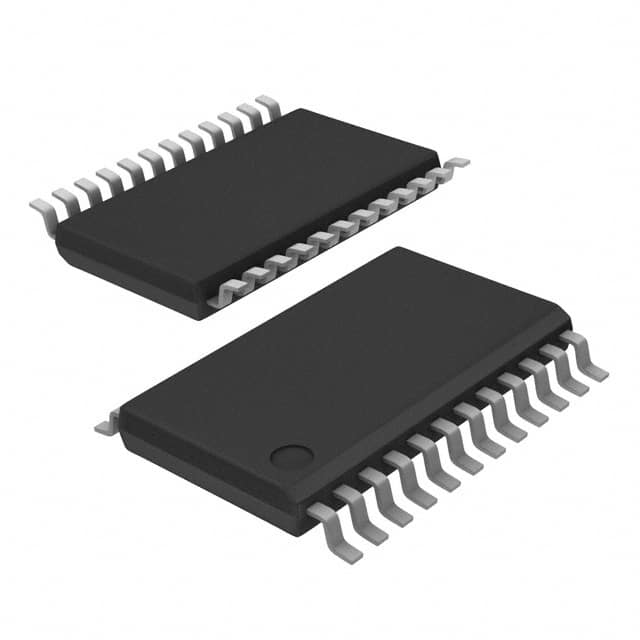Consulte las especificaciones para obtener detalles del producto.

74HC4067PW,118
Basic Information Overview
- Category: Integrated Circuit (IC)
- Use: Multiplexer/Demultiplexer
- Characteristics: High-speed CMOS logic, low power consumption
- Package: TSSOP-24
- Essence: Analog Multiplexer/Demultiplexer
- Packaging/Quantity: Tape and Reel, 2500 pieces per reel
Specifications
- Supply Voltage Range: 2V to 6V
- On-state Resistance: 70Ω (typical) at VCC = 4.5V
- Channel-to-channel Crosstalk: -80dB at f = 1MHz
- Operating Temperature Range: -40°C to +125°C
Detailed Pin Configuration
The 74HC4067PW,118 has a total of 24 pins arranged as follows:
___________
| |
1 | OEN/INH | 24
2 | S0 | 23
3 | S1 | 22
4 | S2 | 21
5 | S3 | 20
6 | E | 19
7 | Z | 18
8 | Y7 | 17
9 | Y6 | 16
10 | Y5 | 15
11 | Y4 | 14
12 | Y3 | 13
|___________|
Functional Features
- The 74HC4067PW,118 is a 16-channel analog multiplexer/demultiplexer.
- It allows digital signals to control the selection of one out of 16 input/output channels.
- The device can be used as a multiplexer to connect multiple analog signals to a single output, or as a demultiplexer to route a single input signal to one of the multiple outputs.
- It features low ON-state resistance and high channel-to-channel isolation.
Advantages and Disadvantages
Advantages: - High-speed CMOS logic allows for fast switching between channels. - Low power consumption makes it suitable for battery-powered applications. - Wide supply voltage range provides flexibility in various circuit designs. - Compact TSSOP-24 package saves board space.
Disadvantages: - Limited to 16 channels, may not be suitable for applications requiring more channels. - Crosstalk between channels may affect signal quality in certain scenarios.
Working Principles
The 74HC4067PW,118 operates based on digital control signals (S0-S3) that determine which channel is connected to the common I/O pin. By setting the appropriate combination of these control signals, the desired input/output channel can be selected. The E (Enable) pin enables or disables the device, allowing for easy control of the multiplexing/demultiplexing operation.
Detailed Application Field Plans
The 74HC4067PW,118 finds applications in various fields, including: 1. Data acquisition systems 2. Communication systems 3. Audio/video signal routing 4. Industrial automation 5. Test and measurement equipment
Detailed and Complete Alternative Models
Some alternative models to the 74HC4067PW,118 include: - CD74HC4067: Similar functionality, different package (DIP-24) - ADG4067: Higher channel count (32 channels), higher performance, different package (LFCSP-32) - MAX4067: Lower power consumption, wider supply voltage range, different package (TQFN-24)
Note: This is not an exhaustive list, and there may be other alternative models available in the market.
Word count: 399 words
Enumere 10 preguntas y respuestas comunes relacionadas con la aplicación de 74HC4067PW,118 en soluciones técnicas
Sure! Here are 10 common questions and answers related to the application of 74HC4067PW,118:
Question: What is the 74HC4067PW,118?
Answer: The 74HC4067PW,118 is a multiplexer/demultiplexer IC that allows you to connect multiple analog or digital signals to a single input/output pin.Question: How many channels does the 74HC4067PW,118 have?
Answer: The 74HC4067PW,118 has 16 channels, which means it can handle up to 16 different signals.Question: Can I use the 74HC4067PW,118 with both analog and digital signals?
Answer: Yes, the 74HC4067PW,118 can be used with both analog and digital signals, making it versatile for various applications.Question: What is the voltage range supported by the 74HC4067PW,118?
Answer: The 74HC4067PW,118 supports a voltage range from 2V to 6V.Question: How do I select a specific channel on the 74HC4067PW,118?
Answer: You can select a specific channel by providing the appropriate binary code to the control pins of the IC.Question: Can I cascade multiple 74HC4067PW,118 ICs together?
Answer: Yes, you can cascade multiple 74HC4067PW,118 ICs together to increase the number of channels available.Question: What is the maximum current rating of the 74HC4067PW,118?
Answer: The 74HC4067PW,118 has a maximum current rating of 25mA per channel.Question: Is the 74HC4067PW,118 compatible with Arduino or other microcontrollers?
Answer: Yes, the 74HC4067PW,118 is compatible with Arduino and other microcontrollers as it operates at standard logic levels.Question: Can I use the 74HC4067PW,118 for audio applications?
Answer: Yes, the 74HC4067PW,118 can be used for audio applications as it supports analog signals.Question: Are there any application examples for the 74HC4067PW,118?
Answer: Yes, some common applications of the 74HC4067PW,118 include signal multiplexing, data acquisition systems, sensor interfacing, and analog/digital signal routing.
Please note that these answers are general and may vary depending on the specific requirements and implementation of the 74HC4067PW,118 in a technical solution.

